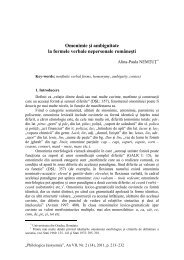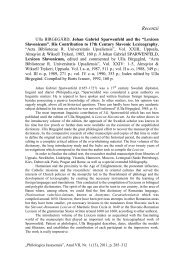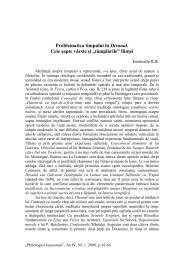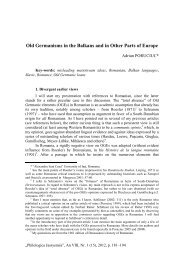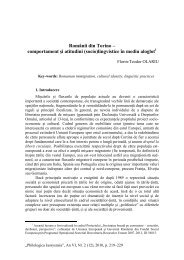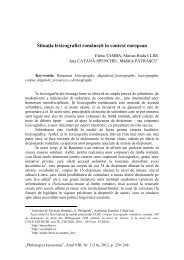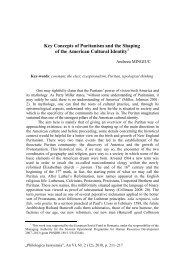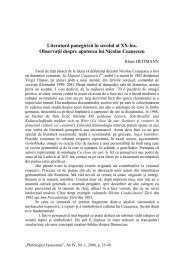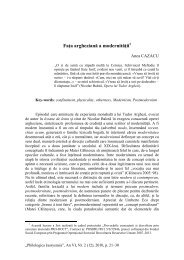Surrealism and The Feminine Element: André Breton's Nadja and ...
Surrealism and The Feminine Element: André Breton's Nadja and ...
Surrealism and The Feminine Element: André Breton's Nadja and ...
Create successful ePaper yourself
Turn your PDF publications into a flip-book with our unique Google optimized e-Paper software.
Ileana Alex<strong>and</strong>ra ORLICH<br />
_______________________________________________________________________________________________________________________________________________________________________________________________<br />
With a name associated, as Marian Papahagi points out, with both a goddess <strong>and</strong><br />
life 17 , Zenobia is a new model for outworldly desire, close to the type Naum describes in<br />
his earlier work, Medium – “a woman waiting for my love, a woman who will objectify<br />
all my desires” (my translation). As embodiment of the feminine principle, Zenobia is<br />
also a Penelope, who waits for the narrator eternally <strong>and</strong> unconditionally. When his<br />
w<strong>and</strong>erings come to an end, <strong>and</strong> when he draws back from the hallucinatory images<br />
overcoming him, the narrator returns home where “in front of the hollow [in the tree],<br />
Zenobia was sitting quietly on a heap of dry reeds with her h<strong>and</strong>s in her lap. Her hair<br />
had turned white from waiting” (192).<br />
In Zenobia’s quasi-chimerical portrayal <strong>and</strong> through the associations of her<br />
character with myth <strong>and</strong> ordinary enchantments, Naum achieves a narrative of<br />
defocalization to foreground without obvious transition the interference of dream <strong>and</strong><br />
reality. More specifically, Zenobia becomes the embodiment of the narrator’s surreal<br />
longings often associated with the feminine 18 . In this sense, both Ion Pop, who talks<br />
about an arrangement of the text around the female characters like Maria, Mrs. Gerda,<br />
<strong>and</strong> the giant matron 19 , <strong>and</strong> Marian Papahagi, who stresses Naum’s focus on the giant<br />
“Woman Spirit” 20 , suggest an examination of Zenobia in terms of female focalization <strong>and</strong> a<br />
feminine thread that carries the narrative. Naum’s own poetic evocations in interconnected<br />
monologues appear symbolically planted to address such a topic when he declares:<br />
”Perhaps it would be fitting to say here that I felt always around me the allencompassing<br />
presence of a feminine principle that, when I tried to define its features,<br />
to give it a face, I named the Woman Spirit. But my receptiveness, still immature,<br />
succeeded only in creating the image of a giant woman, as big as the world”. (97)<br />
Characterized by structures of diffusion <strong>and</strong> polivocality as “mother of all<br />
mothers, ferocious <strong>and</strong> indifferent, gentle <strong>and</strong> generous, deaf, primitive, <strong>and</strong> infinitely<br />
superior to my rude masculinity, she protected me, she shielded me, she guided me<br />
through the complicated appearance that envelops us like the air we breathe, without<br />
being aware of it” (97), Naum’s “Woman Spirit” experiences both human <strong>and</strong><br />
extraterrestrial characteristics. While coming to terms with “the brightness of this<br />
intuitive concept” (97) of her “prefigured ‘giantism’ [that] had become for me a kind of<br />
purely spiritual, abstract, fluid, <strong>and</strong> formless dimension in which immensity <strong>and</strong><br />
smallness, anomaly <strong>and</strong> naturalness, promiscuity <strong>and</strong> splendor coexisted” (99), Naum<br />
formulates a discourse that resembles a ludic feminism by partaking of the difference<br />
within, or différence, which undermines the notion of individual identity. Furthermore,<br />
by disrupting the mimetic program of realism in the representation of women, Naum’s<br />
portrayal of the Woman Spirit appears in line with Christine Buci-Gluksmann’s claim<br />
that “the metaphor of the feminine rises up as an element in the break with a certain<br />
17<br />
Marian Papahagi, În cǎutarea sensului, Cumpǎnǎ şi semn, Bucureşti, Editura Cartea românească,<br />
1990, p. 36-42.<br />
18<br />
I am thinking, for instance, of Henry James’s novella Madame de Mauves, where Euphemia de<br />
Mauves, born Clève, becomes the embodiment of Longmore’s infatuated sensations.<br />
19<br />
Ion Pop, Gellu Naum: Poezia contra literaturii, Cluj, Casa Cǎrţii de Ştiinţǎ, 2001, p. 165.<br />
20 Marian Papahagi, În cǎutarea sensului..., p. 36-42.<br />
222



